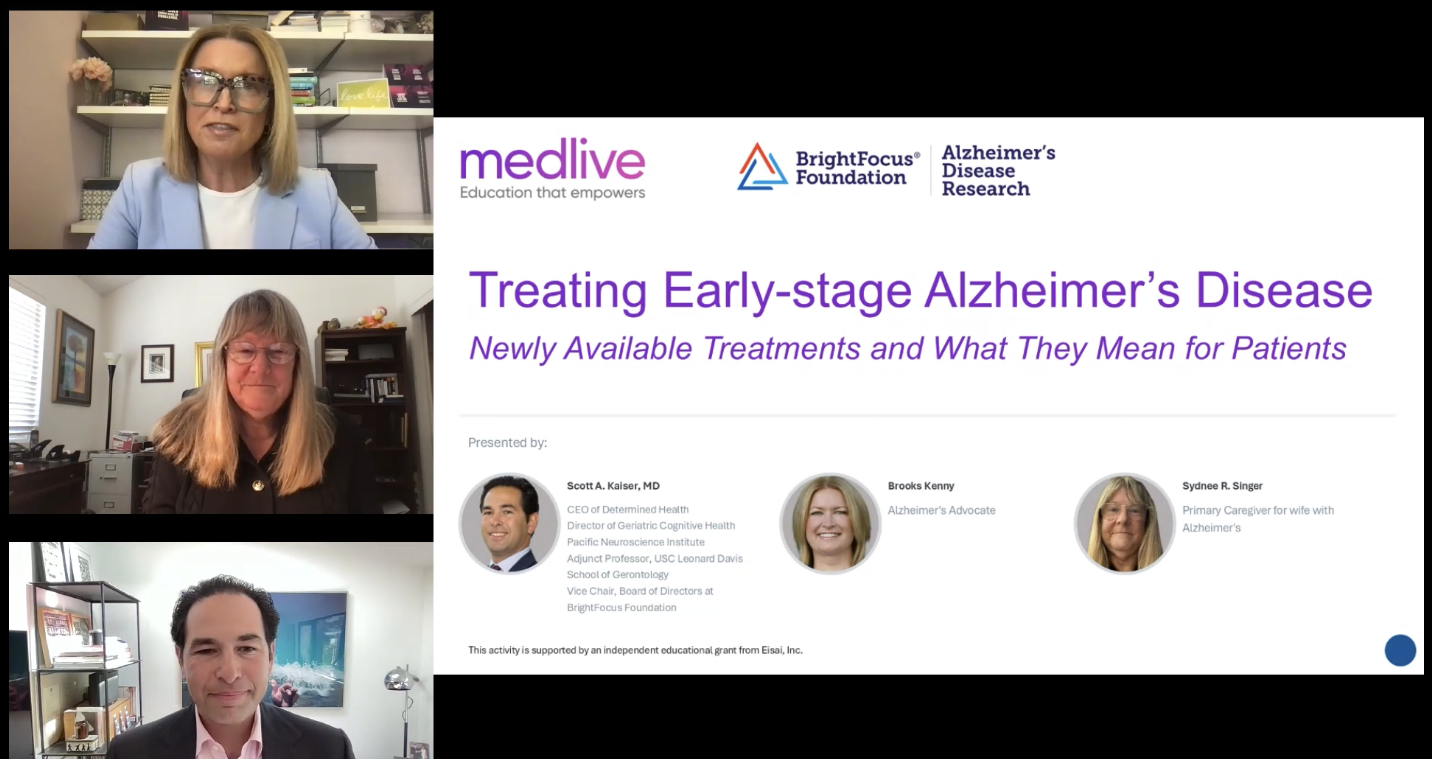
Learn about the symptoms associated with the early, middle, and late stages of frontotemporal dementia.
Joseph’s wife, Emily, was shocked when he approached a young woman in the street, a stranger to him, and complimented her attractive dress. Looking back, Emily had to admit her husband had been acting strangely for several months. Even before his retirement the year before, at age 62, he’d been getting less tidy, more irritable, and less considerate. When Emily was upset about a conflict at work, Joseph shrugged off her concern and didn’t seem to care as he always had in the past. Joseph didn’t seem to enjoy retirement as much as Emily thought he would. He didn’t show much motivation to keep appointments or do things around the house, and his hobbies held less interest for him than in the past. Emily made an appointment for Joseph’s condition to be evaluated. Barbara, a former novelist, found it more and more difficult to write as she neared her 60th birthday. She couldn’t find the words she wanted as easily, and couldn’t understand some words that were previously familiar, not just names but also more common nouns. Her spelling seemed worse, too, which was a real change for a former spelling-bee champion like her. She was short- tempered at times, had difficulty sleeping, and seemed to have developed new and peculiar food preferences. Barbara’s son brought her for evaluation. Lloyd, 59 years old and still working hard to put his children through college, had been a top car salesman for the previous decade. His performance was slipping, for no apparent reason. When he talked with his customers, his speech was different – halting and grammatically incorrect. He wasn’t connecting with them as well as he always had previously. Something seemed to be wrong and his sister suggested he seek evaluation. *The names and details in this story are composite and fictitious. They do not identify specific individuals.
On the surface, Joseph, Barbara, and Lloyd may not seem to be experiencing related changes. Each of them, though, turned out to be in the early stage of frontotemporal dementia (FTD). FTD is the diagnosis for about 10-20% of people with dementia, though estimates vary. About 60% of people living with FTD are 45-65 years old, making it among the most common type of dementia in the “young old.” FTD involves degeneration of the frontal and temporal lobes of the brain. The frontal lobes are an important regulator of behavior, and the temporal lobes assist in our understanding and expression of language. The initial symptoms of FTD, therefore, include major changes in behavior, impairment of language, or both.
People diagnosed with FTD and family members often ask, “What stage of dementia is occurring?” The answer to this question can be useful in knowing what to expect in the future. FTD often begins during years when adults expect to be healthy and productive. The average course of the disease takes roughly 8 years after diagnosis, so patients and their families must confront very serious and increasingly difficult needs. Detailed and complex timelines of the stages of FTD are not very accurate, but it is useful to think of the development of FTD through early, middle, and late stages.
Below we’ve outlined the stages of frontotemporal dementias to see how these related disorders evolve:
Early-Stage Frontotemporal Dementia
There are three primary subtypes of FTD, two of which are more common during the initial stages. During this period, disease subtypes show their most unique features. Memory is often spared at the beginning, and perhaps for this reason early stage FTD can easily be overlooked or misdiagnosed as a psychiatric condition.
The behavioral type of FTD, called behavioral variant FTD, is the most common subtype. It affects personality and social and personal behavior early on. Like Joseph, a person with behavioral variant FTD can start to disregard the usual social boundaries and say or do inappropriate things. They can behave impulsively, carelessly, or even criminally. Judgment and handling of money may deteriorate. Apathy (a lack of emotion) is common, and the person may lose interest in hobbies and self-care. Empathy or concern for others’ feelings and needs often diminishes as well.
Another subtype of FTD is primary progressive aphasia, which impacts a person’s ability to communicate in several different ways. Difficulties can arise in speaking, reading, writing, and language comprehension. Those with this subtype are organized into one of three different groups:
- Semantic: In the early stages, this is characterized by the loss of names for people, places, and objects, word-finding difficulties, and difficulty understanding specific single words. As in Barbara’s case, grammar may remain correct despite trouble grasping the meaning of specific words. Behavioral changes are common, too, including irritability, trouble sleeping, depression, and emotional withdrawal. Selective eating and compulsive behaviors may also develop.
- Agrammatic: This subtype shows itself through the development of labored and halting speech, like Lloyd’s. Grammar is misused, and speech sounds can be distorted. Patients can understand single words and simple sentences but get confused with more complicated sentences such as “The dog that belonged to Billy was running away.”
- Logopenic: People in this group will have a hard time finding their words while speaking but will understand what another person has said. They do not have issues with grammar, rather they just spend more time searching for the right word.
Middle-Stage Frontotemporal Dementia
In its later phases, the symptoms of FTD variants become more similar and memory deterioration begins. In behavioral variant FTD, people are likely to need more assistance with basic daily tasks, such as dressing, bathing, and grooming. Disturbances in behavior may also become more frequent and consistent. Further, those whose problems were initially more behavioral can develop language difficulties and those whose language was more impaired can develop behavior problems.
Late-Stage Frontotemporal Dementia
The latest stage sees a progressive worsening of symptoms for language and behavior. Memory loss will also become more prominent at this stage, often resembling that of early Alzheimer’s disease. The brain’s temporal lobes are involved in not only language but learning and memory as well. To that end, FTD-related degeneration of the temporal lobes could underlie the memory symptoms observed at this stage.
The third subtype of FTD, movement disorders, and its related symptoms also come to the forefront at this stage. Similar to Parkinson’s, a person with this subtype may experience rigidity, slowness of movement, muscle weakness, and difficulty swallowing. FTD is associated with two rare neurological disorders that belong to this group:
- Corticobasal syndrome: A disorder that involves the loss of nerve cells and shrinkage in parts of the brain. An individual may gradually lose the function of their arms or hands, sometimes appearing on one side of the body and then progressing to the other side. Additional symptoms, like rigidity, difficulty swallowing, language difficulties, and impaired spatial orientation may occur.
- Progressive supranuclear palsy: People with this condition may experience issues with balance and walking and often exhibit similar symptoms to Parkinson’s disease, frequently resulting in misdiagnosis. Difficulty with eye movements, like looking down, is also recognized as a tell-tale sign of the disease.
At this stage, it may become necessary to have care around the clock to assure safety and adequate care. FTD can lead to an increased risk of infections, dangerous behaviors, and fall injuries.
On average, people live 7-13 years after symptoms arise. Dementia patients, including those with FTD, often have a weakened immune system by this stage, which leaves them vulnerable to infection. The most common cause of death for people with FTD, and dementia as a whole, is pneumonia.
Summary
FTD has no specific medication or treatment, but there are valuable information resources for caregivers and patients through the Association for Frontotemporal Dementia. The behavioral symptoms of FTD sometimes respond to off-label medications to help with apathy, depression, mania, agitation, irritability, aggression, or delusions. Cognitive rehabilitation and speech therapy may address some language difficulties.
Many researchers, including those funded by BrightFocus Foundation’s Alzheimer’s Disease Research program, are seeking to understand the genetics, pathophysiology, and potential treatments for FTD, in the hope that research will eventually identify disease-modifying or preventive treatments.
About BrightFocus Foundation
BrightFocus Foundation is a premier global nonprofit funder of research to defeat Alzheimer’s, macular degeneration, and glaucoma. Through its flagship research programs — Alzheimer’s Disease Research, Macular Degeneration Research, and National Glaucoma Research— the Foundation has awarded nearly $300 million in groundbreaking research funding over the past 51 years and shares the latest research findings, expert information, and resources to empower the millions impacted by these devastating diseases. Learn more at brightfocus.org.
Disclaimer: The information provided here is a public service of BrightFocus Foundation and is not intended to constitute medical advice. Please consult your physician for personalized medical, dietary, and/or exercise advice. Any medications or supplements should only be taken under medical supervision. BrightFocus Foundation does not endorse any medical products or therapies.
- Other Dementias










